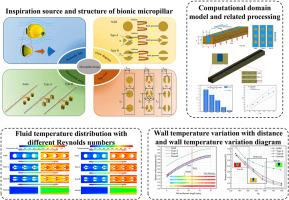Bio-inspired micropillar arrays for enhanced thermal-hydraulic performance in microchannel heat sinks: A numerical and experimental study
IF 5
2区 工程技术
Q1 ENGINEERING, MECHANICAL
International Journal of Thermal Sciences
Pub Date : 2025-09-26
DOI:10.1016/j.ijthermalsci.2025.110342
引用次数: 0
Abstract
Microchannel heat exchanger is an efficient solution for addressing the thermal management challenges posed by high power devices. Embedding solid micropillars within microchannels has proven to be an effective method for enhancing heat transfer. However, the formation of vortices behind these micropillars increases pressure drop and leads to heat accumulation inside the channels. Drawing inspiration from the streamlined body of the butterflyfish, two micropillars Type A and a modified Type B were designed, incorporating an arc-shaped "fish tail" with a slotted structure to reduce flow resistance. The thermal and hydrodynamic characteristics of this new microchannel heat exchanger were investigated through both numerical simulation and experimental study. The laser micromilling method was used to fabricate the bionic micropillars on the bottom of rectangular microchannels. The results indicate that the Nusselt number of Type A micropillars is 8.2–16.5 % higher than that of solid micropillars, with a corresponding pressure drop reduction of 7.8–16 %. Type B micropillars demonstrate a 2.7–12.5 % increase in Nusselt number and a reduction of 10.1–16.7 % in the pressure drop. Performance evaluation criterion (PEC) values for Type A range from 1.01 to 1.71, while Type B ranges from 0.99 to 1.67, highlighting excellent overall heat transfer performance. The superior performance is attributed to the secondary flow formed by bionic micropillars, promoting fluid continuity and providing sufficient momentum to overcome viscous forces along the flow direction. These findings highlight the potential of biomimetic strategies in advancing microchannel heat sink design.

微通道散热器中用于增强热水力性能的仿生微柱阵列:数值和实验研究
微通道热交换器是解决大功率器件热管理挑战的有效解决方案。在微通道内嵌入固体微柱已被证明是一种有效的增强传热的方法。然而,在这些微柱后面形成的漩涡增加了压降,导致通道内的热量积累。从蝴蝶鱼流线型的身体中汲取灵感,设计了两个A型和一个改进的B型微柱,结合了弧形的“鱼尾”和开槽结构,以减少流动阻力。通过数值模拟和实验研究了这种新型微通道换热器的热工和水动力特性。采用激光微铣削方法在矩形微通道底部制备仿生微柱。结果表明:A型微柱的努塞尔数比固体微柱高8.2 ~ 16.5%,压降降低7.8 ~ 16%;B型微柱的努塞尔数增加2.7 ~ 12.5%,压降降低10.1 ~ 16.7%。A型的性能评价标准(PEC)值范围为1.01至1.71,而B型的范围为0.99至1.67,突出了出色的整体传热性能。这种优异的性能归功于仿生微柱形成的二次流,促进了流体的连续性,并提供了足够的动量来克服沿流动方向的粘性力。这些发现突出了仿生策略在推进微通道散热器设计方面的潜力。
本文章由计算机程序翻译,如有差异,请以英文原文为准。
求助全文
约1分钟内获得全文
求助全文
来源期刊

International Journal of Thermal Sciences
工程技术-工程:机械
CiteScore
8.10
自引率
11.10%
发文量
531
审稿时长
55 days
期刊介绍:
The International Journal of Thermal Sciences is a journal devoted to the publication of fundamental studies on the physics of transfer processes in general, with an emphasis on thermal aspects and also applied research on various processes, energy systems and the environment. Articles are published in English and French, and are subject to peer review.
The fundamental subjects considered within the scope of the journal are:
* Heat and relevant mass transfer at all scales (nano, micro and macro) and in all types of material (heterogeneous, composites, biological,...) and fluid flow
* Forced, natural or mixed convection in reactive or non-reactive media
* Single or multi–phase fluid flow with or without phase change
* Near–and far–field radiative heat transfer
* Combined modes of heat transfer in complex systems (for example, plasmas, biological, geological,...)
* Multiscale modelling
The applied research topics include:
* Heat exchangers, heat pipes, cooling processes
* Transport phenomena taking place in industrial processes (chemical, food and agricultural, metallurgical, space and aeronautical, automobile industries)
* Nano–and micro–technology for energy, space, biosystems and devices
* Heat transport analysis in advanced systems
* Impact of energy–related processes on environment, and emerging energy systems
The study of thermophysical properties of materials and fluids, thermal measurement techniques, inverse methods, and the developments of experimental methods are within the scope of the International Journal of Thermal Sciences which also covers the modelling, and numerical methods applied to thermal transfer.
 求助内容:
求助内容: 应助结果提醒方式:
应助结果提醒方式:


